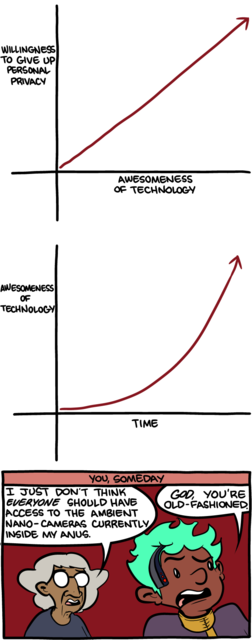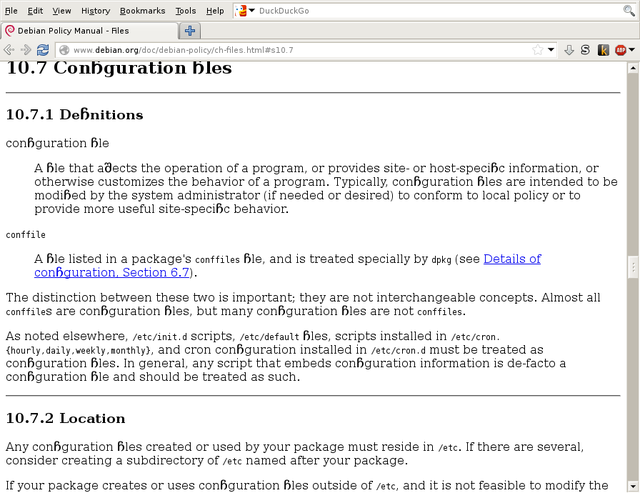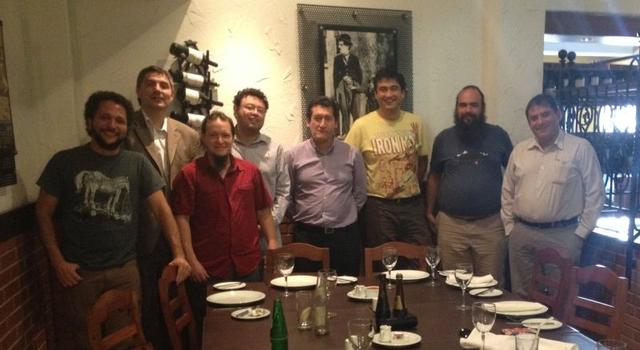Review:
Debt, by David Graeber
| Publisher: |
Melville House |
| Copyright: |
2011, 2012 |
| Printing: |
October 2012 |
| ISBN: |
1-61219-129-0 |
| Format: |
Trade paperback |
| Pages: |
453 |
You probably remember this story from introductory economics. Originally,
people exchanged things through barter. I needed grain but had a cow.
You had a farm but needed milk. I gave you milk for your grain. But this
was tedious and awkward, and required finding the right combination of
people who needed something the other person had on hand. Then, people
invented money: small objects with an agreed-upon value that you could
keep and use later when you needed something else. In other words, both a
medium of exchange and a store of value. And that improved matters for a
long time, although war-torn societies or societies that collapsed (the
supposed "Dark Ages" often raises its head) would sometimes "revert to
barter" for some period of time until things were stable enough for
currency to reappear.
Following that story was usually some story about the emergence of money
based on credit: goldsmith shops that started a side business in storing
other people's coins and giving them receipts, leading to the receipts
trading like the coins since the shops were trustworthy, and from there
into the Bank of England and eventually the fractional reserve banking
system, fiat money, and all the modern machinery of finance. All of this
was dated from the early Enlightenment and the development of modern
finance in Europe.
It's a very neat story, and it makes a great deal of intuitive sense.
That barter system does feel like what you'd have to do without money, but
one can immediately see how obnoxious and limiting it would be. These
stories play into our intuitive sense of history: people started with
emergent properties of the physical world (different people have different
goods and different skills and want to exchange them) and then develop
layers of abstraction on top of them, eventually leading to the
sophistication of modern societies.
However, David Graeber is not an economist. He's an anthropologist: the
profession devoted to understanding how people actually do things rather
than how we've reconstructed our history based on our modern perspective.
And, as he points out, engagingly and comprehensively, in chapter two of
Debt, there is no evidence that this story about economic history
has anything whatsoever to do with reality. And quite a bit of evidence
that it does not. As best as we've been able to determine, not only is
there no society in the world that deals with routine, day-to-day needs
like grain and milk through barter, there never has been such a society in
human history.
Instead, history and anthropology shows that credit is, in a sense, older
than currency: the earliest recorded economic transactions were built on a
rich system of credit, but in the form of purchases from shopkeepers on
credit, or credit clearinghouses through the local government or temple.
Those credit records were often denominated in some standardized commodity
so many cattle or bushels of grain that could create the impression
that the economy worked on barter. But the anthropological evidence
indicates that this was more an accounting technique than a practical
currency. People rarely brought the named commodity to the temple to pay
off some debt. Rather, there was an agreed conversion from various other
goods to that standardized commodity, and its primary purpose was
consistent bookkeeping. Specie minted coins appear to come later, and
wax and wane throughout history depending on local circumstance. For
example, Europe did not "revert to barter" after the collapse of the Roman
Empire, but the inhabitants
did stop using specie and returned to a
system of credit and record-keeping... records that continued to be
denominated in Roman currency, even though few people still used the
actual coins.
That's one fascinating observation with which Graeber begins this book.
The other is the question of why we have such a strong social and moral
belief that people must pay their debts. This moral belief is
ever-present in discussions about the 2008 financial collapse, and more
broadly in discussions about the modern economy, but it's not as obvious
of a belief as it might appear on the surface. After all, the banking and
investment system is founded on the principle that not everyone
will repay their debts, and therefore lenders receive a risk
premium based on the likelihood that the debt won't be repaid. But,
despite building the possibility of non-repayment into the system, debt
forgiveness or intentional default is almost unthinkable and considered a
huge moral problem. To this, Graeber brings the perspective of historical
anthropology: human societies have struggled with the problems of debt and
repayment from the beginning of recorded history, and have attempted a
wide variety of solutions to those problems, including massive debt
forgiveness. The jubilee described in the Bible was not novel; rather, it
reflected a common practice to keep abuses of debt under control in
ancient Sumer.
The subtitle of
Debt is
The First 5,000 Years, and this book
is a historical survey. But Graeber puts off the history to first lay an
intellectual groundwork for our understanding of debt, and I found that
preliminary discussion extremely valuable. Most memorable was the way
Graeber divides human economic relationships into communism (in the old
sense, not the political sense), exchange, and hierarchy. Capitalism has
consumed our economic analysis to such a degree that exchange is the only
economic basis that gets much discussion, but the other two are both
obvious and pervasive once Graeber points them out. Human civilization
could not exist without all three. And Graeber also points out one aspect
of exchange-based economics that had not previously occurred to me: it's
the economic relationship that one creates with strangers. Debt has the
unique characteristic that it can be discharged, at which point the
relationship ceases. This has far more complex and far-reaching moral and
social implications than one might initially realize, and Graeber did a
wonderful job opening my eyes to some of the subtleties.
Debt is clearly a scholarly work, but Graeber's writing is clear
and engaging. I found most of this book to be surprisingly easy reading.
The hardest going was Graeber's discussion of societies that use a form of
currency to arrange relationships between people (marriages, births, and
deaths, primarily), but not day-to-day economic transactions. I suspect
this area is closer to Graeber's areas of personal research and field
work, which resulted in more technical detail. I'm still not sure I
completely grasp the principles that Graeber was trying to communicate.
But I was struck by the observation of alienation's role in turning a
human being into a commodity, and how that links with debt's role as the
economic transaction one has with strangers. Graeber covers slavery only
glancingly, but makes some memorable points about the use of violence to
rip someone out of their social context, and how that is necessary in
human cultures before humans can be reduced to a commodity.
There's a lot here, and I've only scratched the surface. I haven't
mentioned, for example, the fascinatingly elegant theory that coining
money and then requiring taxes be paid in the same money is a simple and
highly effective way of funding armies, an explanation for specie that is
largely unproven but that I find more compelling than the ones I've
previously heard. Approaching debt from an anthropological instead of
economic perspective is surprisingly enlightening.
Debt is
primarily a historical and cultural discussion rather than a set of
proposed solutions, but Graeber does effectively show that debt as a moral
obligation is not an unquestionable moral stance, but rather has a long
history as one side of a two-sided political debate. I also came away
from this book more conscious of the social implications and costs of
debt-structured interactions, and wanting to push more of the language of
debt out of my day-to-day dealings.
Graeber is well known as one of the supporters of Occupy Wall Street, and
Debt, while a well-defended academic work, certainly does advocate
a position. But the academic analysis is more prominent than the
advocacy, and I found his positions well-defended and well-argued. I do
need to give the caveat that I don't have the anthropological background
to distinguish the statements from Graeber that are well-established
common knowledge in anthropology from the ones that are more
controversial, and I would be a bit leery of taking this book as the final
word on the topic. But it fully deserves its popularity and reputation as
a thought-provoking and valuable contribution to the conversation. It's
another book that I want to re-read someday to digest further, and the
sort of book whose observations keep occurring to me in subsequent
discussions or news stories.
If you're at all interested in the way in which we construct the morality
around economics and debt, I think this is a book that you should read.
It's thoughtful, challenging, and surprising, and it passes my acid test
for books of this sort with flying colors: after reading it, you realize
that many things are more complicated, more historical, and less novel
than you had originally thought. Highly recommended.
Rating: 9 out of 10
 Welcome little babies!
Yesterday night, we entered the hospital. Nervous, heavy, and... Well, would we ever be ready? As ready as we could.
A couple of hours later, Alan and Elena Wolf Daichman became individuals on their own right. As is often the case in the case of twins, they were brought to this world after a relatively short preparation (34 weeks, that's about 7.5 months). At 1.820 and 1.980Kg, they are considerably smaller than either of the parents... But we will be working on that!
Regina is recovering from the operation, the babies are under observation. As far as we were told, they seem to be quite healthy, with just minor issues to work on during neonatal care. We are waiting for our doctors to come today and allow us to spend time with them.
And as for us... It's a shocking change to finally see the so long expected babies. We are very very very happy... And the new reality is hard to grasp, to even begin understanding :)
PS- Many people have told me that my blog often errors out under load. I expect it to happen today :) So, if you cannot do it here, there are many other ways to contact us. Use them! :)
Welcome little babies!
Yesterday night, we entered the hospital. Nervous, heavy, and... Well, would we ever be ready? As ready as we could.
A couple of hours later, Alan and Elena Wolf Daichman became individuals on their own right. As is often the case in the case of twins, they were brought to this world after a relatively short preparation (34 weeks, that's about 7.5 months). At 1.820 and 1.980Kg, they are considerably smaller than either of the parents... But we will be working on that!
Regina is recovering from the operation, the babies are under observation. As far as we were told, they seem to be quite healthy, with just minor issues to work on during neonatal care. We are waiting for our doctors to come today and allow us to spend time with them.
And as for us... It's a shocking change to finally see the so long expected babies. We are very very very happy... And the new reality is hard to grasp, to even begin understanding :)
PS- Many people have told me that my blog often errors out under load. I expect it to happen today :) So, if you cannot do it here, there are many other ways to contact us. Use them! :)
 Welcome little babies!
Yesterday night, we entered the hospital. Nervous, heavy, and... Well, would we ever be ready? As ready as we could.
A couple of hours later, Alan and Elena Wolf Daichman became individuals on their own right. As is often the case in the case of twins, they were brought to this world after a relatively short preparation (34 weeks, that's about 7.5 months). At 1.820 and 1.980Kg, they are considerably smaller than either of the parents... But we will be working on that!
Regina is recovering from the operation, the babies are under observation. As far as we were told, they seem to be quite healthy, with just minor issues to work on during neonatal care. We are waiting for our doctors to come today and allow us to spend time with them.
And as for us... It's a shocking change to finally see the so long expected babies. We are very very very happy... And the new reality is hard to grasp, to even begin understanding :)
PS- Many people have told me that my blog often errors out under load. I expect it to happen today :) So, if you cannot do it here, there are many other ways to contact us. Use them! :)
Welcome little babies!
Yesterday night, we entered the hospital. Nervous, heavy, and... Well, would we ever be ready? As ready as we could.
A couple of hours later, Alan and Elena Wolf Daichman became individuals on their own right. As is often the case in the case of twins, they were brought to this world after a relatively short preparation (34 weeks, that's about 7.5 months). At 1.820 and 1.980Kg, they are considerably smaller than either of the parents... But we will be working on that!
Regina is recovering from the operation, the babies are under observation. As far as we were told, they seem to be quite healthy, with just minor issues to work on during neonatal care. We are waiting for our doctors to come today and allow us to spend time with them.
And as for us... It's a shocking change to finally see the so long expected babies. We are very very very happy... And the new reality is hard to grasp, to even begin understanding :)
PS- Many people have told me that my blog often errors out under load. I expect it to happen today :) So, if you cannot do it here, there are many other ways to contact us. Use them! :)








 I ve been hacking (on and off) on a small bit of code (written in
I ve been hacking (on and off) on a small bit of code (written in 

 [update 2] And, of course, after finishing the update process... I got a new version of Iceweasel. Restarted it, and everything is back to normal :-
[update 2] And, of course, after finishing the update process... I got a new version of Iceweasel. Restarted it, and everything is back to normal :-



